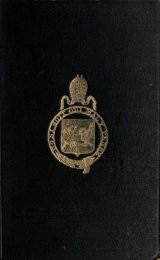- Page 2:
This page intentionally left blank
- Page 8:
COLLOQUIAL AND LITERARY LATIN edite
- Page 12:
In honour of J. N. Adams
- Page 18:
viii Contents 9 The fragments of Ca
- Page 22:
Contributors professor brigitte l.
- Page 26:
Acknowledgements Thanks are due abo
- Page 30:
xiv Foreword the University Medal f
- Page 34:
xvi Foreword and authors are concer
- Page 38:
xviii Foreword that he has studied
- Page 44:
chapter 1 Introduction Eleanor Dick
- Page 48:
Introduction 5 lacks a colloquial r
- Page 52:
chapter 2 Colloquial language in li
- Page 56:
Colloquial language in linguistic s
- Page 60:
Colloquial language in linguistic s
- Page 64:
Roman authors on colloquial languag
- Page 68:
Roman authors on colloquial languag
- Page 72:
Roman authors on colloquial languag
- Page 76:
Roman authors on colloquial languag
- Page 80:
Roman authors on colloquial languag
- Page 84:
Roman authors on colloquial languag
- Page 88: Roman authors on colloquial languag
- Page 92: Roman authors on colloquial languag
- Page 96: Roman authors on colloquial languag
- Page 100: Roman authors on colloquial languag
- Page 104: Roman authors on colloquial languag
- Page 108: Roman authors on colloquial languag
- Page 112: Roman authors on colloquial languag
- Page 116: Roman authors on colloquial languag
- Page 120: Roman authors on colloquial languag
- Page 124: Colloquial language in literary stu
- Page 128: Colloquial language in literary stu
- Page 132: Colloquial language in literary stu
- Page 136: Colloquial language in literary stu
- Page 142: 52 anna chahoud does not work both
- Page 146: 54 anna chahoud ‘plebeian’) pra
- Page 150: 56 anna chahoud etc.; extra-literar
- Page 154: 58 anna chahoud emphasising the nee
- Page 158: Colloquial language in literary stu
- Page 162: 62 anna chahoud Juvenal, and with t
- Page 166: 64 anna chahoud 4 conclusions The v
- Page 170: 66 eleanor dickey in the ordinary c
- Page 174: 68 eleanor dickey the understanding
- Page 180: chapter 6 Possessive pronouns in Pl
- Page 184: Possessive pronouns in Plautus 73 B
- Page 188:
Possessive pronouns in Plautus 75 (
- Page 192:
Possessive pronouns in Plautus 77 t
- Page 196:
Possessive pronouns in Plautus 79 I
- Page 200:
Possessive pronouns in Plautus 81 i
- Page 204:
Possessive pronouns in Plautus 83 b
- Page 208:
Possessive pronouns in Plautus 85 i
- Page 212:
Possessive pronouns in Plautus 87 H
- Page 216:
Possessive pronouns in Plautus 89 u
- Page 220:
Possessive pronouns in Plautus 91
- Page 224:
Possessive pronouns in Plautus 93 T
- Page 228:
Possessive pronouns in Plautus 95 (
- Page 232:
Possessive pronouns in Plautus 97 f
- Page 236:
Possessive pronouns in Plautus 99 a
- Page 240:
Greeting and farewell expressions 1
- Page 244:
Greeting and farewell expressions 1
- Page 248:
Greeting and farewell expressions 1
- Page 252:
Greeting and farewell expressions 1
- Page 256:
Greeting and farewell expressions 1
- Page 260:
Greeting and farewell expressions 1
- Page 264:
Greeting and farewell expressions 1
- Page 268:
Greeting and farewell expressions 1
- Page 272:
Greeting and farewell expressions 1
- Page 276:
Greeting and farewell expressions 1
- Page 280:
Greeting and farewell expressions 1
- Page 284:
Greeting and farewell expressions 1
- Page 288:
Greeting and farewell expressions 1
- Page 292:
chapter 8 Colloquial and literary l
- Page 296:
Early Roman tragedy 129 playwrights
- Page 300:
Early Roman tragedy 131 Perhaps the
- Page 304:
Early Roman tragedy 133 to the more
- Page 308:
Early Roman tragedy 135 influences.
- Page 312:
Early Roman tragedy 137 Lennartz (2
- Page 316:
Early Roman tragedy 139 letters, it
- Page 320:
Early Roman tragedy 141 probable th
- Page 324:
Early Roman tragedy 143 interesting
- Page 328:
Early Roman tragedy 145 (Casaceli 1
- Page 332:
Early Roman tragedy 147 5.12 intere
- Page 336:
Early Roman tragedy 149 expressions
- Page 340:
Early Roman tragedy 151 (b) atque e
- Page 344:
Early Roman tragedy 153 the author
- Page 348:
The fragments of Cato’s Origines
- Page 352:
The fragments of Cato’s Origines
- Page 356:
The fragments of Cato’s Origines
- Page 360:
part iii Classical Latin
- Page 366:
164 j. g. f. powell Scholars in the
- Page 370:
166 j. g. f. powell scale: there ar
- Page 374:
168 j. g. f. powell refined, since
- Page 378:
170 j. g. f. powell a ‘hyperbaton
- Page 382:
172 j. g. f. powell are often loose
- Page 386:
174 j. g. f. powell that e.g. quid
- Page 390:
176 j. g. f. powell natos, magna vi
- Page 394:
178 j. g. f. powell usage: we would
- Page 398:
180 j. g. f. powell dispatch as exe
- Page 402:
182 j. g. f. powell Short-range A n
- Page 406:
184 j. g. f. powell auspiciis utunt
- Page 410:
chapter 11 Notes on the language of
- Page 414:
188 harm pinkster What were the cir
- Page 418:
190 harm pinkster the effect mentio
- Page 422:
192 harm pinkster decem ipsos dies
- Page 426:
194 harm pinkster si sine suo peric
- Page 430:
196 harm pinkster consists in the f
- Page 434:
198 harm pinkster preceding discour
- Page 438:
200 harm pinkster last example is e
- Page 442:
202 harm pinkster whole ground so m
- Page 446:
204 tobias reinhardt Latin poetic l
- Page 450:
206 tobias reinhardt nam tibi de su
- Page 454:
208 tobias reinhardt such features
- Page 458:
210 tobias reinhardt preferred cand
- Page 462:
212 tobias reinhardt abituque, | ha
- Page 466:
214 tobias reinhardt in Lucretius)
- Page 470:
216 tobias reinhardt mingle with ki
- Page 474:
218 tobias reinhardt quae . . . cre
- Page 478:
220 tobias reinhardt The replacemen
- Page 482:
222 tobias reinhardt We proceed to
- Page 486:
224 tobias reinhardt readership. 32
- Page 490:
226 tobias reinhardt Lucretius occa
- Page 494:
228 tobias reinhardt retention of a
- Page 498:
230 andreas willi Our present focus
- Page 502:
232 andreas willi could not simply
- Page 506:
234 andreas willi particular figure
- Page 510:
236 andreas willi connection with t
- Page 514:
238 andreas willi ‘urbem’ et
- Page 518:
240 andreas willi one disregards ot
- Page 522:
242 andreas willi other writings al
- Page 526:
244 jan felix gaertner agreed that
- Page 530:
246 jan felix gaertner interpretati
- Page 534:
248 jan felix gaertner use with the
- Page 538:
250 jan felix gaertner semper, mane
- Page 542:
252 jan felix gaertner 3thebellum h
- Page 546:
254 jan felix gaertner and colloqui
- Page 550:
256 richard f. thomas issues, or ev
- Page 554:
258 richard f. thomas or otherwise)
- Page 558:
260 richard f. thomas itself to epi
- Page 562:
262 richard f. thomas 97-100: they
- Page 566:
264 richard f. thomas in divination
- Page 570:
chapter 16 Sermones deorum: divine
- Page 574:
268 stephen j. harrison quid meus A
- Page 578:
270 stephen j. harrison Jupiter ope
- Page 582:
272 stephen j. harrison Here the lo
- Page 586:
274 stephen j. harrison of the hexa
- Page 590:
276 stephen j. harrison (Pl. Bac. 2
- Page 594:
278 stephen j. harrison leads to a
- Page 600:
chapter 17 Petronius’ linguistic
- Page 604:
Petronius’ linguistic resources 2
- Page 608:
Petronius’ linguistic resources 2
- Page 612:
Petronius’ linguistic resources 2
- Page 616:
Petronius’ linguistic resources 2
- Page 620:
Petronius’ linguistic resources 2
- Page 624:
Parenthetical remarks in the Silvae
- Page 628:
Parenthetical remarks in the Silvae
- Page 632:
Parenthetical remarks in the Silvae
- Page 636:
Parenthetical remarks in the Silvae
- Page 640:
Parenthetical remarks in the Silvae
- Page 644:
Parenthetical remarks in the Silvae
- Page 648:
Parenthetical remarks in the Silvae
- Page 652:
Parenthetical remarks in the Silvae
- Page 656:
Parenthetical remarks in the Silvae
- Page 660:
Parenthetical remarks in the Silvae
- Page 664:
Parenthetical remarks in the Silvae
- Page 668:
Parenthetical remarks in the Silvae
- Page 672:
1.5 Balneum Claudii Etrusci: 61-2 1
- Page 676:
Colloquial Latin in Martial’s epi
- Page 680:
Colloquial Latin in Martial’s epi
- Page 684:
Colloquial Latin in Martial’s epi
- Page 688:
Colloquial Latin in Martial’s epi
- Page 692:
Colloquial Latin in Martial’s epi
- Page 696:
Colloquial Latin in Martial’s epi
- Page 700:
chapter 20 Current and ancient coll
- Page 704:
Current and ancient colloquial in G
- Page 708:
Current and ancient colloquial in G
- Page 712:
Current and ancient colloquial in G
- Page 716:
chapter 21 Forerunners of Romance -
- Page 720:
Forerunners of Romance -mente adver
- Page 724:
Forerunners of Romance -mente adver
- Page 728:
Forerunners of Romance -mente adver
- Page 732:
Forerunners of Romance -mente adver
- Page 736:
Forerunners of Romance -mente adver
- Page 740:
Forerunners of Romance -mente adver
- Page 744:
Forerunners of Romance -mente adver
- Page 752:
chapter 22 Late sparsa collegimus:
- Page 756:
The sources and language of Jordane
- Page 760:
The sources and language of Jordane
- Page 764:
The sources and language of Jordane
- Page 768:
The sources and language of Jordane
- Page 772:
The sources and language of Jordane
- Page 776:
The sources and language of Jordane
- Page 780:
The sources and language of Jordane
- Page 784:
The sources and language of Jordane
- Page 788:
The sources and language of Jordane
- Page 792:
The tale of Frodebert’s tail 377
- Page 796:
The tale of Frodebert’s tail 379
- Page 800:
The tale of Frodebert’s tail 381
- Page 804:
The tale of Frodebert’s tail 383
- Page 808:
The tale of Frodebert’s tail 385
- Page 812:
The tale of Frodebert’s tail 387
- Page 816:
The tale of Frodebert’s tail 389
- Page 820:
The tale of Frodebert’s tail 391
- Page 824:
The tale of Frodebert’s tail 393
- Page 828:
The tale of Frodebert’s tail 395
- Page 832:
The tale of Frodebert’s tail 397
- Page 836:
The tale of Frodebert’s tail 399
- Page 840:
The tale of Frodebert’s tail 401
- Page 844:
The tale of Frodebert’s tail 403
- Page 848:
The tale of Frodebert’s tail 405
- Page 852:
Latin colloquies 407 fetch his clot
- Page 856:
Latin colloquies 409 composed in La
- Page 860:
Latin colloquies 411 gloss, leaving
- Page 864:
Latin colloquies 413 and u in texts
- Page 868:
Latin colloquies 415 (E. Löfstedt
- Page 872:
Latin colloquies 417 Similarly, in
- Page 876:
chapter 25 Conversations in Bede’
- Page 880:
Conversations in Bede’s Historia
- Page 884:
Conversations in Bede’s Historia
- Page 888:
Conversations in Bede’s Historia
- Page 892:
Conversations in Bede’s Historia
- Page 896:
Conversations in Bede’s Historia
- Page 900:
Abbreviations abbreviations of anci
- Page 904:
Abbreviations 433 Orat. Orator Phil
- Page 908:
Abbreviations 435 Jord. Jordanes Go
- Page 912:
Abbreviations 437 Quint. M. Fabius
- Page 916:
Abbreviations 439 A. Riese, Antholo
- Page 920:
References Abbot, F. F. 1907. ‘Th
- Page 924:
References 443 (edd.), Latin et lan
- Page 928:
References 445 Bettini, M. 1982.
- Page 932:
References 447 Calboli Montefusco,
- Page 936:
References 449 Cordier, A. 1939. É
- Page 940:
References 451 Fantham, E. 1972. Co
- Page 944:
References 453 Goodyear, F. R. D. 1
- Page 948:
References 455 Herren, M. W. 1995.
- Page 952:
References 457 1927a. C. Iuli Caesa
- Page 956:
References 459 Leumann, M. 1947.
- Page 960:
References 461 (ed.) 1923. Incerti
- Page 964:
References 463 Norden, E. 1899. Die
- Page 968:
References 465 1993a. ‘Aspetti e
- Page 972:
References 467 Sato, S. 1990. ‘Ch
- Page 976:
References 469 1945. ‘Colloquial
- Page 980:
References 471 Weissenborn, W. and
- Page 984:
Ablabius 360 ablative absolute 189
- Page 988:
e for i 360, 413 elegy 215 élite s
- Page 992:
Neoteric poetry 63 n. 60 Nepos 245,
- Page 996:
spelling xvii, 20 n. 15, 54, 232 wi
- Page 1000:
(a) Latin words and expressions ab
- Page 1004:
et tu 123-4 etenim 220-1, 364-5 eti
- Page 1008:
opino(r) 17 with n. 10, 146, 224, 3
- Page 1012:
tra(ns)vorsus 158-9, 253 n. 94; de
- Page 1016:
Accius 2 Ribbeck: 141 3: 140 123: 1
- Page 1020:
4.1: 244, 248 n. 36, 250 n. 58 4.2:
- Page 1024:
7.48.1: 251 n. 69 7.77.14: 247 n. 3
- Page 1028:
Fat. 24: 38 38: 44 n. 5 Fin. 1.5: 1
- Page 1032:
5.10: 413, 417 n. 24 5.14-15: 416 5
- Page 1036:
Furius Bibaculus fr. 15 Courtney: 2
- Page 1040:
2.1.32: 44 n. 5 2.1.46: 263 2.2.10:
- Page 1044:
1069: 57 n. 39 1130: 20 1249: 43 n.
- Page 1048:
5.78.22: 323 5.82.3: 322 5.83.2: 32
- Page 1052:
41.12: 282 42.1-7: 282 42.4: 49 43.
- Page 1056:
533: 332 n. 6 579: 94 593: 213 602:
- Page 1060:
4.43: 26 4.44: 163, 174, 177 4.45:
- Page 1064:
4.4.57: 317 4.4.58-60: 317 4.5: 315
- Page 1068:
4.117-19: 272 4.271: 276 5.311: 248








